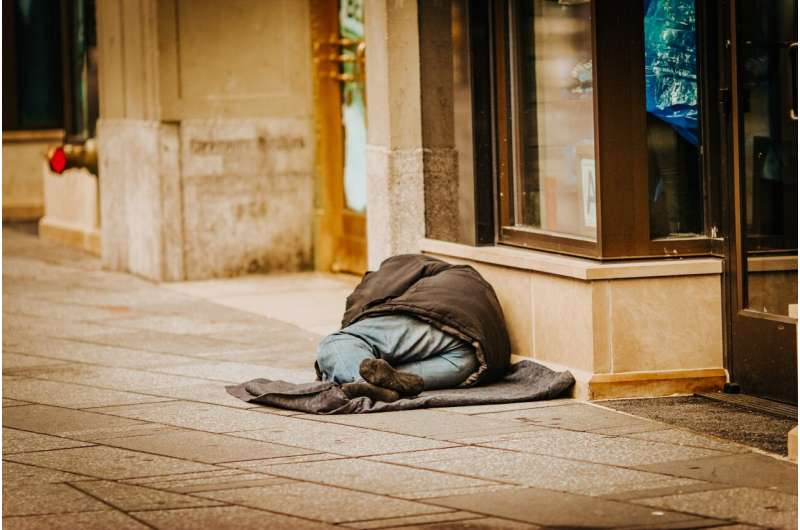This article has been reviewed according to Science X's editorial process and policies. Editors have highlighted the following attributes while ensuring the content's credibility:
fact-checked
trusted source
written by researcher(s)
proofread
Homeless service providers could help more people if they measured success differently, researcher says

Homelessness is a major problem in the U.S., and it's getting worse: A record 650,000 Americans were homeless on a single night in January 2023, according to the most recent point-in-time report released by the U.S. Department of Housing and Urban Development. That amounts to 1 out of every 500 people nationwide.
My state, Georgia, has seen a consistent rise in homelessness since 2017. By 2022, the number of unsheltered homeless individuals in Georgia—in other words, those living on the street or in cars—surpassed those who had access to emergency shelter, according to state data.
Politicians have been paying attention: Every year, the federal government allocates billions in funding to local governments and nonprofit service providers to help fight homelessness. Yet this money hasn't been enough to turn the tide. Why?
Homelessness has many complex causes, including unemployment, housing affordability and health problems. But speaking as a professor of operations management, I think an underappreciated problem is how homeless service providers—mainly nonprofits—measure success. Too often, the system incentivizes quick fixes over long-term solutions.
Nonprofits offer a wide but threadbare safety net
Across the U.S., nonprofit agencies offer a range of services to people who are homeless, including shelter, housing, rehabilitation, job training and counseling. There are more than 12,000 such providers nationwide, including over 50 in metro Atlanta alone.
Homeless service providers, like other nonprofits, often publish metrics of impact to illustrate their success. This doesn't just help them gain insight into the effectiveness of their operations—it also helps them communicate their values to the government, donors and the public.
Homeless service providers often tout their effectiveness in terms of meals served, beds provided or classes offered, research has shown. However, none of these measurements reflect success in terms of reducing homelessness.
These are measures of outputs, not impact. Outputs are the tangible results of activities, while impact refers to long-term changes and benefits from activities. It's surprisingly uncommon to see homeless service providers measure impact related to reducing homelessness—that is, whether the people served have become self-sufficient and are no longer homeless.
That's a mistake. Business research shows that the way nonprofits measure success directly affects how they set priorities. Depending on the characteristics of clients and services, homeless service providers might be able to generate higher social impact—in other words, do more good—by prioritizing case-resolution rates over the number of clients served.
To be clear, homeless service providers are making remarkable contributions to communities across the U.S., and my intention isn't to criticize them. Rather, I want to highlight how the sector often focuses on measuring outputs rather than impact. This focus naturally influences their activities and ultimate success.
A better path for homeless service providers
How can nonprofits measure impact in the context of homelessness?
They can start by considering the sustained outcome of their services, such as the number of people who became self-sufficient; the average time it takes for rehabilitation, job training and placement; and the starting salary of people who get assistance with employment and subsequently find jobs.
They can take it a step further by considering the percentage of clients served who remained employed for more than a year, who could pay child custody for more than a year, or who had not been arrested for more than a year after being served.
You may say, correctly, that these are difficult objectives to measure. But some organizations have shown that it's possible to do.
For instance, Georgia Works has helped more than 1,000 individuals exit homelessness. And if you check their website, you'll see they're gauging their impact based on the above measures. This is an organization focused on helping its clients become self-sufficient.
Beyond measuring impact, it's also critical for nonprofits to effectively communicate these measures to funders such as government agencies and donors. Without clear communication, organizations that focus solely on output measures may appear more productive even if their activities lack lasting impact. This could result in more funding being allocated to those organizations rather than to ones that are creating a more genuine and long-lasting impact.
By prioritizing and standardizing impact measures and clearly communicating them with funders, Americans can reduce homelessness and build stronger, more resilient communities.
Provided by The Conversation
This article is republished from The Conversation under a Creative Commons license. Read the original article.![]()





















